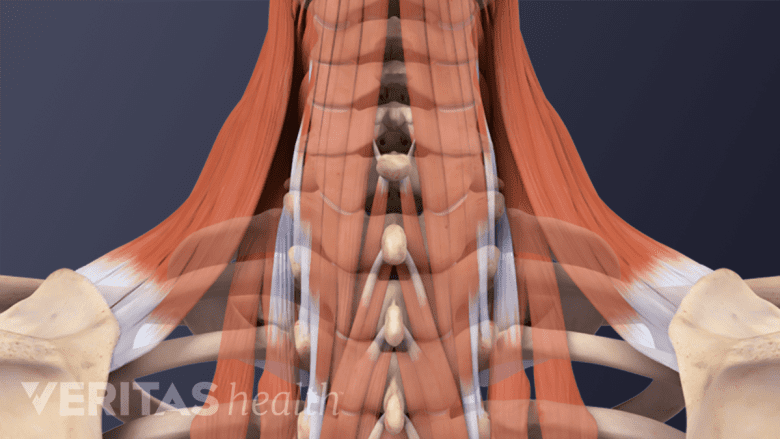When neck aches and stiffness become chronic, it is likely that daily habits are either causing or worsening the pain. Evaluating posture throughout the day, as well as activities and stressors, may reveal opportunities to make changes that can help reduce neck pain and stiffness.
In This Article:
- How to Treat Chronic Stiff Neck
- Self-Care for Chronic Stiff Neck
- Lifestyle Changes to Treat Chronic Stiff Neck
- Manual Manipulation and Mobilization for Chronic Stiff Neck
- Massage Therapy for Chronic Stiff Neck
- Acupuncture for Chronic Stiff Neck
Practice Good Posture
Regularly using poor posture on a daily basis can cause the head to drift too far forward as the neck and upper back muscles become weakened and/or tightened, which overwork the cervical spine and lead to chronic neck aches and stiffness. Some tips for using better posture throughout the day include:
Sitting with the head in neutral position by keeping the ears directly above the shoulders. Whether sitting at the office, on the couch, or in the car, it is advisable to keep the head in neutral position, which places less stress on the cervical spine.
Taking breaks and stretching on a regular basis. When possible, taking a break from sitting or repetitive work at least every hour can reduce the risk of straining the neck. The break can be as simple as a short walk or simple range-of-motion neck stretches while still sitting at a desk or in a break room. Also, some work environments offer the option of working while standing, such as with an adjustable desk, which may be beneficial for some people.
See Workplace Ergonomics and Neck Pain
Several other routines throughout the day might also need to be re-evaluated, such as carrying a heavy backpack or bag over one shoulder, which could cause a muscle imbalance and lead to pain and stiffness in the neck and shoulder region.
See 3 Ways to Improve Forward Head Posture
Get Regular Exercise
Chronic neck aching and stiffness can make exercise more challenging, but keeping active when possible is typically good for the neck. Some ideas to try include:
Daily neck strengthening and stretching

The chin tuck exercise helps strengthen the muscles of the neck.
Performing daily strengthening and stretching can help keep the neck’s muscles strong and flexible, which can lead to better neck function and possibly less pain. One good example includes chin tucks, which involve looking straight ahead while pulling the head and chin straight back and holding for a few seconds before repeating. This exercise can be repeated multiple times throughout the day.
See Daily Exercises and Stretches to Prevent Neck Pain
Low-impact aerobic exercise

Low-impact aerobic exercise boosts blood flow, promotes healing, and alleviates pain.
Low-impact aerobic exercise can increase blood flow—rich in oxygen and healing nutrients—throughout the body (including the neck), maintain coordination and endurance, and may also provide a boost in mood. Current U.S. government guidelines call for most adults to get at least 150 minutes of moderate-intensity aerobic exercise each week.1U.S. Centers for Disease Control and Prevention website. Updated July 2018. Some examples include brisk walking, biking, or water aerobics.
See Low-Impact Aerobic Exercise
Especially when starting a new exercise routine, it is normal to experience some increased muscle soreness after the activity. However, if neck pain significantly increases during exercise, the activity should be stopped. A doctor or physical therapist may need to be consulted to design an exercise program that fits the patient’s needs.
Sleep Well
Getting good sleep and keeping the cervical spine in a comfortable position throughout the night may help reduce neck pain and stiffness. Some ideas to consider include:
Sleep position. Sleeping on the back or side tends to be recommended rather than sleeping on the stomach, which puts the most stress on the cervical spine. Some people with a stiff or achy neck find that sleeping in a reclined position is most comfortable for the neck.
Watch: Pillows and Positions for Easing Neck Pain Video
Pillow and mattress. Side sleepers may prefer a thicker pillow to help maintain a straight (neutral) spine, whereas back sleepers may prefer a thinner pillow to avoid forward head posture. Finding the most comfortable pillow can take some trial and error. Additionally, an old or soft mattress may need to be rotated, flipped, or replaced with a firmer one.
See Sleeping with Neck Pain: What You Need to Know
Sleep hygiene. Maintaining good habits during the day and right before bedtime can help facilitate a more restful night’s sleep. Some examples include avoiding TV and smartphone screen time shortly before bed, and keeping a similar bedtime each night.
Some sleep habits may be hard to change and take multiple tries, such as changing sleep position or keeping a regular bedtime.
Reduce and Manage Stress
Stress and anxiety can play a role in causing neck pain and stiffness in some people. In addition to getting enough sleep, exercising regularly, and eating healthy, some ideas to reduce and/or better manage stress include:
Support group. Meeting and talking with other people who are going through similar struggles with chronic pain may provide an emotional lift and/or new tips for managing chronic pain. Some groups meet locally, such as through an organization, and others might be available online.
Cognitive behavioral therapy. A therapist may be able to help a patient think about struggles with chronic pain in a more positive manner, which might lead to an improved ability to manage stress or follow doctor’s instructions.
Time management. Having too much to do or feeling overwhelmed are common ways to become overstressed. Taking time to prioritize what is truly important can help eliminate or delay other projects or obligations, making more time for rest and enjoyable activities.
Many other stress-management tips are available. If stress or anxiety is suspected of contributing to neck pain, it is advised to see a medical doctor for an evaluation.
Evidence for Lifestyle Changes to Treat Stiff Neck
Multiple studies have linked stress with chronic pain.2Rees CS, Smith AJ, O’Sullivan PB, Kendall GE, Straker LM. Back and neck pain are related to mental health problems in adolescence. BMC Public Health. 2011; 11:382.,3Blozik E, Laptinskaya D, Herrmann-Lingen et al. Depression and anxiety as major determinants of neck pain: a cross-sectional study in general practice. 2009; 10:13. Furthermore, a known symptom of anxiety is neck pain, including neck stiffness. Treating the underlying causes of stress and anxiety may help reduce chronic pain in some cases, but not all.
Studies have also suggested that staying active and keeping muscles strong and flexible can reduce back and neck pain in some people.4Babatunde OO, Jordan JL, Van der windt DA, Hill JC, Foster NE, Protheroe J. Effective treatment options for musculoskeletal pain in primary care: A systematic overview of current evidence. PLoS ONE. 2017;12(6):e0178621.,5Bertozzi L, Gardenghi I, Turoni F, et al. Effect of therapeutic exercise on pain and disability in the management of chronic nonspecific neck pain: systematic review and meta-analysis of randomized trials. Phys Ther. 2013; 93(8):1026-36.,6Shiri R, Coggon D, Falah-Hassani K. Exercise for the prevention of low back pain: systematic review and meta-analysis of controlled trials. 2018; 187(5):1093-1101.
Read more about Treatment for a Stiff Neck
- 1 U.S. Centers for Disease Control and Prevention website. Updated July 2018.
- 2 Rees CS, Smith AJ, O’Sullivan PB, Kendall GE, Straker LM. Back and neck pain are related to mental health problems in adolescence. BMC Public Health. 2011; 11:382.
- 3 Blozik E, Laptinskaya D, Herrmann-Lingen et al. Depression and anxiety as major determinants of neck pain: a cross-sectional study in general practice. 2009; 10:13.
- 4 Babatunde OO, Jordan JL, Van der windt DA, Hill JC, Foster NE, Protheroe J. Effective treatment options for musculoskeletal pain in primary care: A systematic overview of current evidence. PLoS ONE. 2017;12(6):e0178621.
- 5 Bertozzi L, Gardenghi I, Turoni F, et al. Effect of therapeutic exercise on pain and disability in the management of chronic nonspecific neck pain: systematic review and meta-analysis of randomized trials. Phys Ther. 2013; 93(8):1026-36.
- 6 Shiri R, Coggon D, Falah-Hassani K. Exercise for the prevention of low back pain: systematic review and meta-analysis of controlled trials. 2018; 187(5):1093-1101.


